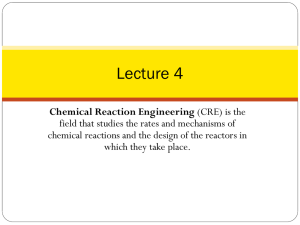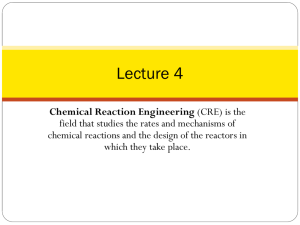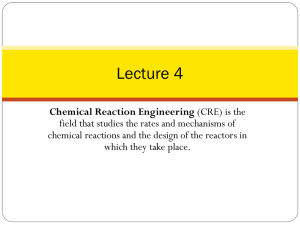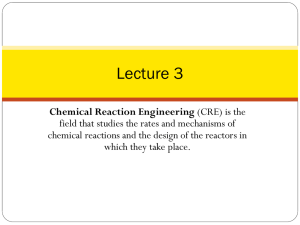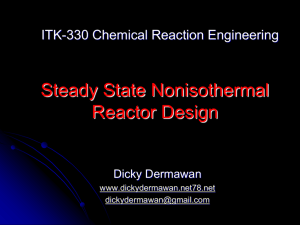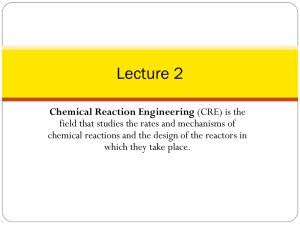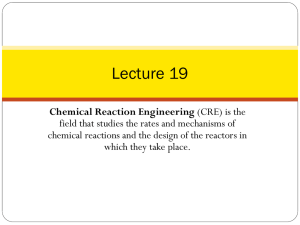Lecture 4
advertisement
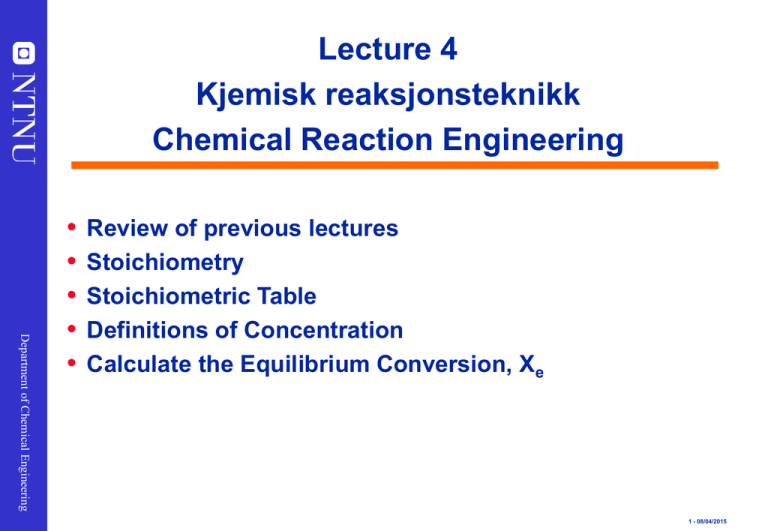
Lecture 4 Kjemisk reaksjonsteknikk Chemical Reaction Engineering Department of Chemical Engineering Review of previous lectures Stoichiometry Stoichiometric Table Definitions of Concentration Calculate the Equilibrium Conversion, Xe 1 - 08/04/2015 Reactor Mole Balances in terms of conversion Reactor Differential Algebraic Integral X X Batch N A0 V CSTR Department of Chemical Engineering 2 PFR dX t N A0 rA V 0 dX r AV dt FA 0 dX rA dV t FA 0 X rA X V FA 0 0 dX rA X PBR FA 0 dX rA dW X W FA 0 0 dX rA W 2 - 08/04/2015 Last Lecture Relative Rates of Reaction aA bB cC dD b c d A B C D a a a Department of Chemical Engineering rC rD rA rB a b c d 3 3 - 08/04/2015 Last Lecture Rate Laws - Power Law Model A B rA kC C α order in A β order in B OverallRect ionOrder α β 2A B 3C Department of Chemical Engineering 4 A reactor follows an elementary rate law if the reaction orders just happens to agree with the stoichiometric coefficients for the reaction as written. e.g. If the above reaction follows an elementary rate law rA k AC2ACB 2nd order in A, 1st order in B, overall third order 4 - 08/04/2015 Last Lecture Arrhenius Equation k is the specific reaction rate (constant) and is given by the Arrhenius Equation. Where: k Ae Department of Chemical Engineering 5 E RT T k A k T 0 k 0 A 1013 T 5 - 08/04/2015 Reaction Engineering Mole Balance Rate Laws Stoichiometry Department of Chemical Engineering These topics build upon one another 6 6 - 08/04/2015 How to find rA f X Department of Chemical Engineering Step 1: Rate Law rA gCi Step 2: Stoichiometry Ci hX Step 3: Combine to get rA f X 7 7 - 08/04/2015 We shall set up Stoichiometry Tables using species A as our basis of calculation in the following reaction. We will use the stochiometric tables to express the concentration as a function of conversion. We will combine Ci = f(X) with the appropriate rate law to obtain -rA = f(X). b c d A B C D a a a Department of Chemical Engineering A is the limiting Reactant. 8 8 - 08/04/2015 NA NA 0 NA 0 X For every mole of A that react, b/a moles of B react. Therefore moles of B remaining: N B0 b b N B N B 0 N A0 X N A0 X a N A0 a Let ΘB = NB0/NA0 Department of Chemical Engineering 9 Then: b N B N A 0 B X a c c NC NC 0 N A 0 X N A 0 C X a a 9 - 08/04/2015 Batch System Stoichiometry Table Species Department of Chemical Engineering 10 Symbol Initial Change Remaining A A NA0 -NA0X NA=NA0(1-X) B B NB0=NA0ΘB -b/aNA0X NB=NA0(ΘB-b/aX) C C NC0=NA0ΘC +c/aNA0X NC=NA0(ΘC+c/aX) D D ND0=NA0ΘD +d/aNA0X ND=NA0(ΘD+d/aX) Inert I NI0=NA0ΘI ---------- NI=NA0ΘI FT0 N C C y Where: i i 0 i 0 0 i 0 i 0 and N A 0 CA 0 0 CA 0 y A 0 NT=NT0+δNA0X d c b 1 a a a δ = change in total number of mol per mol A reacted 10 - 08/04/2015 Constant Volume Batch Note: If the reaction occurs in the liquid phase or if a gas phase reaction occurs in a rigid (e.g. steel) batch reactor Then V V0 Department of Chemical Engineering N A N A 0 1 X CA CA 0 1 X V V0 N B N A 0 b b CB B X CA 0B X V V0 a a etc. 11 11 - 08/04/2015 Stoichiometry Suppose rA kA C CB Batch: V V0 2 A rA k A CA 0 2 b 1 X B X a 2 Department of Chemical Engineering Equimolar feed: B 1 Stoichiometric feed: b B a 12 12 - 08/04/2015 Flow System Stochiometric Table Department of Chemical Engineering 13 Species Symbol Reactor Feed Change Reactor Effluent A A FA0 -FA0X FA=FA0(1-X) B B FB0=FA0ΘB -b/aFA0X FB=FA0(ΘB-b/aX) Where: i Fi0 C C y i0 0 i0 i0 FA 0 CA 0 0 CA 0 y A 0 13 - 08/04/2015 Flow System Stochiometric Table Species Symbol Reactor Feed Change C C FC0=FA0ΘC +c/aFA0X FC=FA0(ΘC+c/aX) D D FD0=FA0ΘD +d/aFA0X FD=FA0(ΘD+d/aX) Inert I FI0=A0ΘI ---------- FI=FA0ΘI FT=FT0+δFA0X FT0 Department of Chemical Engineering 14 Reactor Effluent Fi 0 C C y i0 0 i0 i0 FA 0 C A 0 0 C A 0 y A 0 Where: i and d c b 1 a a a Concentration – Flow System FA CA 14 - 08/04/2015 Flow System Stochiometric Table Department of Chemical Engineering 15 Species Symbol Reactor Feed Change Reactor Effluent A A FA0 -FA0X FA=FA0(1-X) B B FB0=FA0ΘB -b/aFA0X FB=FA0(ΘB-b/aX) C C FC0=FA0ΘC +c/aFA0X FC=FA0(ΘC+c/aX) D D FD0=FA0ΘD +d/aFA0X FD=FA0(ΘD+d/aX) Inert I FI0=FA0ΘI ---------- FI=FA0ΘI FT=FT0+δFA0X FT0 Where: i Fi 0 C C y i0 0 i0 i0 FA 0 C A 0 0 C A 0 y A 0 Concentration – Flow System CA and d c b 1 a a a FA 15 - 08/04/2015 Concentration Flow System: Liquid Phase Flow System: FA CA 0 Liquid Systems Department of Chemical Engineering FA FA 0 1 X CA CA 0 1 X Flow Liquid Phase 0 CB NB NA0 b b X C X B A0 B V V0 a a etc. 16 16 - 08/04/2015 Liquid Systems rA kCA CB If the rate of reaction were rA CA 0 then we would have This gives us Department of Chemical Engineering 17 2 b 1 X B X a rA f X FA 0 rA X 17 - 08/04/2015 For Gas Phase Flow Systems Combining the compressibility factor equation of state with Z = Z0 Stoichiometry: Department of Chemical Engineering 18 P CT ZRT P0 CT 0 Z 0 R0T0 FT CT V FT 0 CT 0V0 We obtain: FT P0 T 0 FT 0 P T0 18 - 08/04/2015 P T0 FT 0 F j P T0 C j Fj FT P0 T 0 FT P0 T 0 FT 0 Fj CT 0 FT 0 0 Department of Chemical Engineering For Gas Phase Flow Systems FB P T0 CB CT 0 FT P0 T 19 19 - 08/04/2015 For Gas Phase Flow Systems The total molar flow rate is: Substituting FT gives: Department of Chemical Engineering 20 FT FT0 FA0X FT 0 FA 0X T P0 0 FT 0 T0 P T P0 FA 0 0 1 X FT 0 T0 P T P0 0 1 y A 0X T0 P T P0 0 1 X T0 P 20 - 08/04/2015 For Gas Phase Flow Systems Department of Chemical Engineering 21 21 - 08/04/2015 For Gas Phase Flow Systems Concentration Flow System: Gas Phase Flow System: Department of Chemical Engineering 22 CA FA CA T P0 0 1 X T0 P FA 0 1 X C 1 X T0 P FA A0 T P0 1 X T P0 0 1 X T0 P b b FA 0 B X C A 0 B X FB a a T0 P CB P T 1 X 1 X T P0 0 0 T0 P 22 - 08/04/2015 For Gas Phase Flow Systems Department of Chemical Engineering b b FA0 j X C A0 j X Fj a a T0 P Cj 1 X T P0 1 X T P0 0 T0 P Cj=f(Fj, T, P) =f(x, T,P) 23 - 08/04/2015 For Gas Phase Flow Systems If –rA=kCACB b 1 X B a X P T 2 2 0 rA k A C A 0 1 X 1 X P0 T Department of Chemical Engineering 24 This gives us FA0/-rA X 24 - 08/04/2015 Example: Calculating the equilibrium conversion for gas phase reaction in a flow reactor, Xef Consider the following elementary reaction with KC=20 dm3/mol and CA0=0.2 mol/dm3. Calculate Equilibrium Conversion or both a batch reactor (Xeb) and a flow reactor (Xef). 2A B Department of Chemical Engineering 2 CB rA k A CA KC 25 25 - 08/04/2015 Department of Chemical Engineering 26 26 - 08/04/2015 Batch Reactor Example Calculating the equilibrium conversion for gas phase reaction,Xe Consider the following elementary reaction with KC=20 m3/mol and CA0=0.2 mol/m3. Xe’ for both a batch reactor and a flow reactor. Department of Chemical Engineering 2A B 2 CB rA k A CA K C 27 27 - 08/04/2015 Example Calculate Xe Batch Reactor CA0 0.2 mol L KC 20 L mol dX rAV dt NA 0 Step 2: rate law, rA k AC2A k BCB Step 1: Department of Chemical Engineering 28 2 CB rA k A CA KC kA KC kB 28 - 08/04/2015 Example Calculate Xe Batch Reactor Symbol Change Remaining A NA0 -NA0X NA0(1-X) B 0 ½ NA0X NA0 X/2 Totals: Department of Chemical Engineering 29 Initial NT0=NA0 NT=NA0 -NA0 X/2 @ equilibrium: -rA=0 CBe Ke 2 CAe 0C CAe CBe 2 Ae C Be KC NAe CA 0 1 X e V Xe CA 0 2 29 - 08/04/2015 Batch Reactor Example Calculating the equilibrium conversion for gas phase reaction Solution: At equilibrium Stoichiometry C Be 2 rA 0 k A C Ae K C C Be KC 2 C Ae A B/ 2 Department of Chemical Engineering V V0 Constant volume Batch Species Initial Change Remaining A NA0 -NA0X NA=NA0(1-X) B 0 +NA0X/2 NB=NA0X/2 NT0=NA0 NT=NA0-NA0X/2 30 30 - 08/04/2015 BR Example Xeb Xe CA0 Xe 2 Ke 2 2 C A 0 1 X e 2C A 0 1 X e Department of Chemical Engineering 2K e C A 0 Xe 2200.2 8 2 1 Xe X eb 0.703 31 31 - 08/04/2015 Gas Phase Example Xef 2A B X eb 0.703 X ef ? Solution: Department of Chemical Engineering Rate law: 2 CB rA k A C A KC 1 A B 2 32 32 - 08/04/2015 Gas Flow Example Xef Species Fed Change Remaining A FA0 -FA0X FA=FA0(1-X) B 0 +FA0X/2 FB=FA0X/2 FT0=FA0 FT=FA0-FA0X/2 Department of Chemical Engineering 33 33 - 08/04/2015 Gas Flow Example Xef A FA0 -FA0X FA=FA0(1-X) B 0 FA0X/2 FB=FA0X/2 Stoichiometry: Gas isothermal T=T0, isobaric P=P0 V V0 1 X Department of Chemical Engineering 34 FA 0 1 X CA 0 1 X CA V0 1 X 1 X FA 0 X 2 CA 0 1 X CB V0 1 X 21 X 34 - 08/04/2015 Gas Flow Example Xef C 1 X 2 C X A0 rA k A A 0 21 X K C 1 X Pure A yA0=1, CA0=yA0P0/RT0, CA0=P0/RT0 Department of Chemical Engineering 35 1 1 y A 0 1 1 2 2 @ eq: -rA=0 2K C C A 0 X e 1 X e 1 X e 2 35 - 08/04/2015 2K C C A 0 dm 3 mol 2 20 8 0.2 3 dm mol 1 1 y A 0 1 1 2 2 Department of Chemical Engineering Gas Flow Example Xef 36 8 X e 0.5X e 2 1 2X e X e 2 8.5X e 2 17X e 8 0 Flow: X ef 0.757 Recall Batch: X eb 0.70 36 - 08/04/2015
